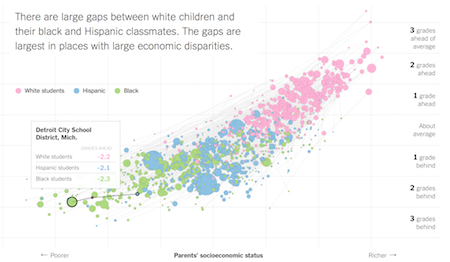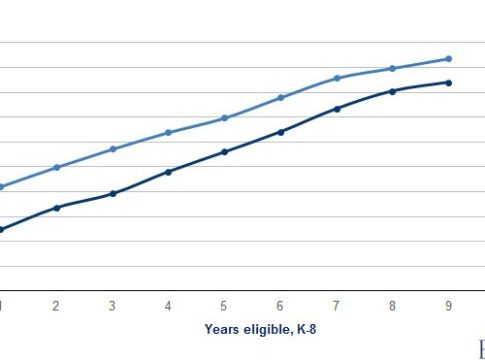On Top of the News
Money, Race and Success: How Your School District Compares
The Upshot | 4/29/16
Behind the Headline
What Matters for Student Achievement
Education Next | Spring 2016
A widely shared post on The Upshot uses a set of colorful graphics to shed light on achievement gaps both within and across school districts. The graphics are based on a new analysis of data by Sean F. Reardon, Demetra Kalogrides and Kenneth Shores of Stanford.
The first graphic shows how much average student performance compares in rich and poor school districts.
The second graphic is interactive and shows how white, black, and Hispanic students are doing within a particular school district. In the school districts represented by pink dots at the upper right corner of the graphic, white students come from wealthy families and are high performing.
If you click on an individual pink dot, a line appears connecting that pink dot to a green dot which shows how the black students in that district are doing and a blue dot which shows how the Hispanic students in that district are doing. In most of the districts, the black and Hispanic students come from much less wealthy families and have much lower test scores.
The third graphic (not shown here) shows the same data but for only those (relatively few) school districts where white, black, and Hispanic students come from similar socioeconomic backgrounds. Even in those districts, there are large gaps between the white students and the black and Hispanic students within the district.
In a recent article for Education Next, Eric Hanushek looked at research on the achievement gap since the Coleman Report shined a spotlight on educational disparities across races in 1966. Hanushek’s article investigates what we have learned since the Coleman Report about the causes of the achievement gap. He concludes
Vastly more jarring is that the central goal of the report—the development of an education system that provides equal educational opportunity for all groups, and especially for racial minorities—has not been attained. Achievement gaps remain nearly as large as they were when Coleman and his team put pen to paper, even when better research has suggested ways to close them and even when policies have been promulgated that supposedly are explicitly designed to eliminate them.
Additional articles on the Coleman Report and the achievement gap can be found in a special issue of Education Next commemorating the 50th anniversary of the Report.
—Education Next





